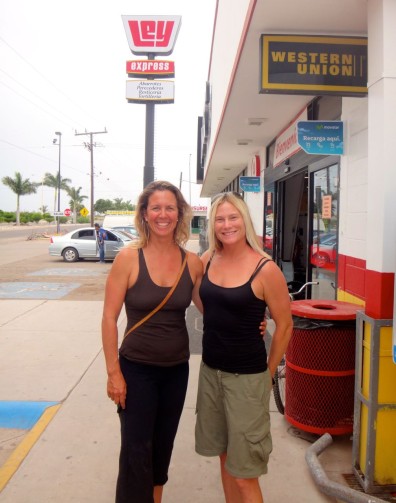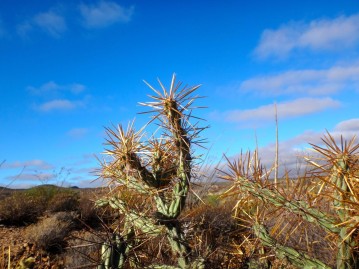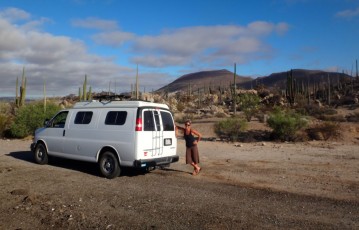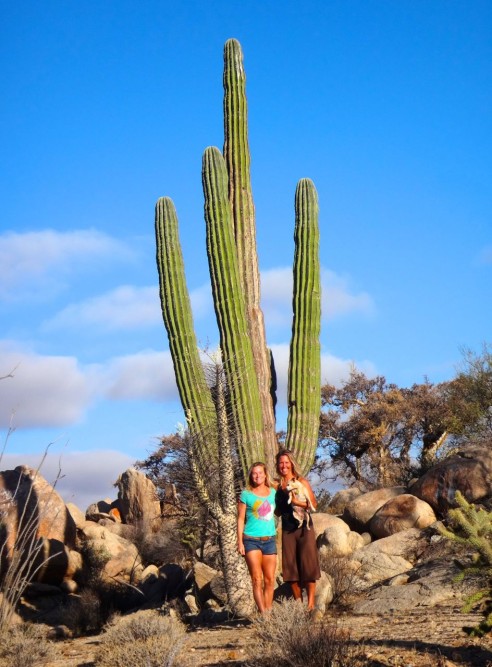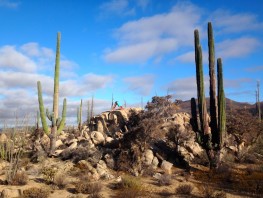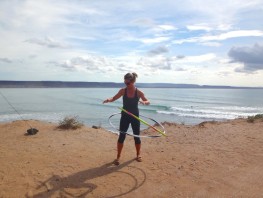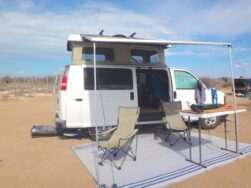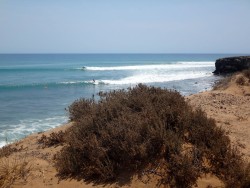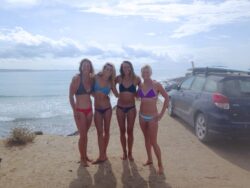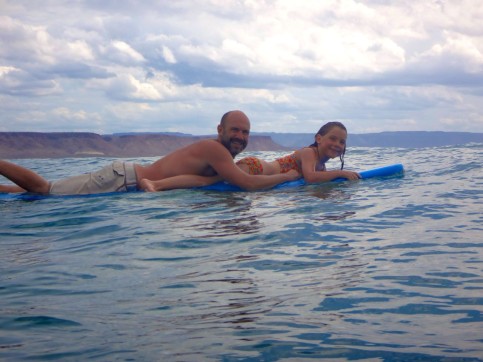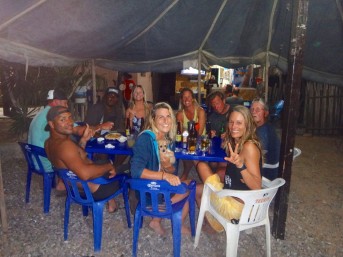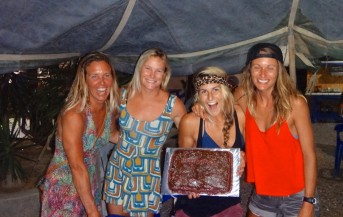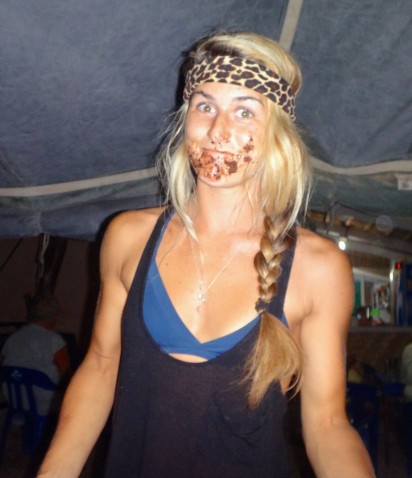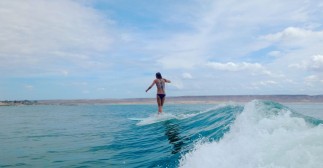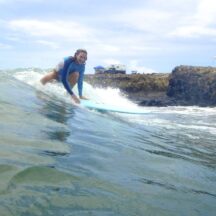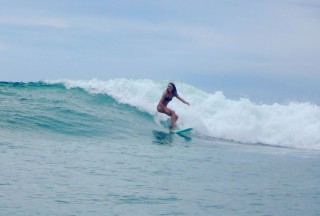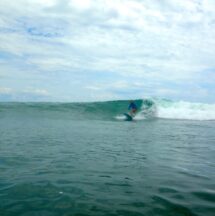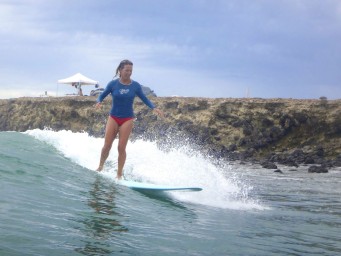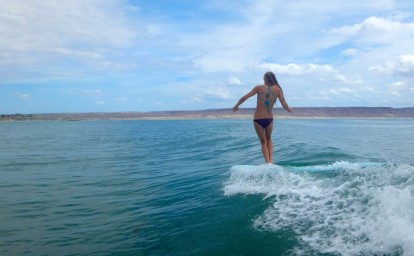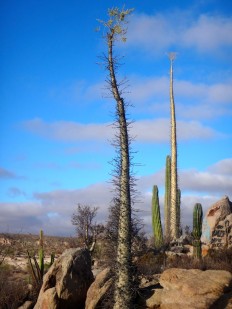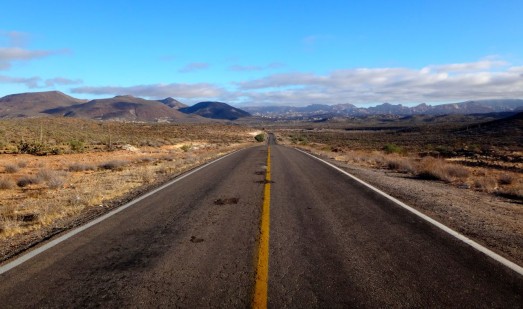A week prior to my departure on the ferry from Mazatlan, Shannon and I made plans to meet at a Ley grocery store in Southern Baja and travel back to California together. The ferry was scheduled to arrive in La Paz at 9:00am. From there, I could catch a morning bus leaving at 9:30am, or alternatively, an afternoon bus at 1:00pm. We figured that the four-hour bus trip would put me at the store by 5:00pm at the latest. I neglected to account for the fact that I was dealing with Mexico time. When the ferry finally pulled into the dock at 12:30pm, three and a half hours late, I was concerned that I might miss the afternoon bus.
On the upper deck of the ferry, I met a man named Lalo who was headed to deliver equipment to some mines. His route passed by the Ley grocery store and he offered to give me a ride, if I needed it. But when the ferry finally pulled into the harbor, drivers were called to disembark first, and I quickly lost track of Lalo as I was ushered onto a shuttle. After I collected my luggage and passed through the agricultural inspection, I waited on the side of the road in the unforgiving midday sun, hoping that Lalo hadn’t forgotten about me. About 20 minutes later, he pulled up smiling, and opened the back door of his work truck so that I could load up my boards.
The passenger seat was covered with a Mexican blanket, and a tiny statue of Jesus adorned the dashboard. Ranchero music played cheerfully on the stereo as the air conditioning blew a cool breeze on my sunburned, sweaty skin. We set off on the coastal highway, heading north through La Paz along the Sea of Cortez, which separates Baja California from the mainland of Mexico. The landscape shone like polished gold under the blazing sun, a picture frame of sand, rock, and cactus for the portrait of ocean below. Even after a lifetime of ocean, the Sea of Cortez is a masterpiece. The shallow water at the shore is a neon turquoise that manages to be both full and transparent, like the voice of a soprano. Farther out, the deep water is a crystalline indigo that sparkles like a rich dark gemstone, the tenor in the opera of the sea.
Lalo and I arrived at the Ley grocery store sometime around 4:00pm. I unloaded my boards, waved to him as he drove off, and went inside to use the restroom. I had scarcely stepped back out when I saw Shannon’s van pulling into the parking lot. We had each travelled over a thousand miles, with no opportunity to communicate for days, and arrived within 10 minutes of each other. It made me wonder if all of the calling, texting, emailing, messaging – everything that allows us to constantly reschedule, rework, revise and rescind our plans – causes us to lose touch with some deeper level of connectedness, a sort of intuition that enables us to operate on the same wavelength.
Baja had been on my bucket list for years, and it was worth the wait to go with Shannon, who has the place dialed. The roads were a tangle of detours and intersections, a skeleton of highway whose fractured bones told a story of flash floods, scouring sand. The cracked clay lowlands were baked into a splintered mosaic of dry mud. And running down the center, a spine of sand buttered with pavement that melted off in rough chunks and splattered on the ground below. At one point, the asphalt ended abruptly, a perfect line of blacktop giving way to earth. As if the road crew ran out of materials, or simply gave up and said, “This is it. No more.”
A few hours later, the faint outline of a town began to take shape on the horizon. Shannon pointed out the tiny general store that supplied a scant selection of produce – bins of onions and potatoes, brown freckled bananas and softly decaying green apples, swathed in an aroma of over-ripeness, guarded by a cloud of circling fruit flies. Continuing past the town, as we wove along the bluffs bordering the ocean, I began to see a glimpse of the famous bay that I had been wanting to visit for so many years.
My opening vision was of First Point, a spectacular sandy bay with long, gentle lines filing in lazily – a longboard paradise, truly a sight to behold, in and of itself. But there was more. Dipping back into the cactus and sand dunes, we traced the edge of the cliff and emerged at Second Point, another bay. A more traditional, high performance setup, the waves wrapped in and broke over a rock shelf, peeling with near-perfect shape and consistency.
It would be a full day before I made it to Third Point, another long, lined-up wave that occasionally barrels on the take-off – and again on the inside – a relatively faster, more powerful break well-suited for shortboarding. It would be two more days before I walked all the way up to Fourth Point, curious as to why the Australians described it as a ‘bombie.’ Fourth Point breaks relatively far from shore, requiring a long paddle or a painful hobble over razor-sharp lava rock, making it less hospitable to beginners, and oftentimes less crowded than the more easily accessible First, Second, and Third.
After we’d been camping in Baja for nearly a week, the swell dropped, so we finally drove out to check Fifth and Sixth Point. Each had all the components of a good break, but I can’t attest to the quality of the waves, since I didn’t see them on a particularly good day, or surf them firsthand. The sheer number and magnitude of world-class right point breaks was overwhelming. The fact that they were so far apart was a blessing; I needed to digest them in pieces. Even after all the places I had travelled, all of the waves I had surfed, it was hard to wrap my head around so many good points, right there, in proximity to one another.
On that first day, we parked the van at Second Point and went out for a quick surf as the sun began to set. The waves were only knee high, but Shannon had brought a spare longboard, so I pulled it out and began to make my way down the cliff to the beach. She advised me to bring my sandals, as the burrs and spines were abundant along the bluffs, and to shuffle my feet when wading out in the shallow water, to drive away stingrays.
Even at a diminutive height, I could feel the potential of the wave at Second Point. People claim that the last hurricane stripped the break of its sand, that the wave isn’t as good as it once was. But I had nothing to compare it to. It was good enough for me. As the light faded I practiced catching tiny waves and moving my feet along the length of the longboard.
From the time I first started to surf, I gravitated toward shortboarding, with a focus on bigger waves and rail-to-rail turns, a totally different experience than longboarding. I never learned the longboard tricks – cross-stepping, nose riding – and tackling them felt like a bright, new challenge. Second Point is perfectly suited for longboarding, with an easy takeoff and a wave that peels for endless, not to mention an inviting sand bottom that negates the need for a lease. If you lose your board, you can simply stand up and wade in to get it.
As darkness set in, we made our way back up to the bluff and set up camp, nearby the bathrooms that were included in our camping fee of 150 pesos (about $10) per person, per night. It seemed like a lot for camping, compared to what I’d been paying, but worth it for a shower. Plus, you couldn’t beat the view. We parked right on the edge of the cliff, facing the waves. I was amazed that the oceanfront was still so rugged and undeveloped. And grateful, that I got to experience it, because it probably won’t be like that forever.
Despite the remote location, there were still many takers. Undeterred by the rough roads, scorpions, mosquitoes, and lack of amenities, hordes of surfers are game to make the drive, which takes two full days from San Diego, and even longer from anywhere else. After endless hours winding through a monotone landscape of cactus and rock, stuck in the window like a song on repeat, one would expect to find some solace. But oftentimes, one arrives to find crowds.
The silver lining was that I liked many of the people that made up the crowd. There was Chloe, who I knew from Santa Cruz. And Jordan, her rad partner in crime. I met the Diamond Surfboards crew from Oceanside, who gave me access to their quiver of boards as the swell picked up, and Third Point began to turn on. Randomly, Shannon and I were camped next to Jed, whom I’d met in El Salvador three years before, and his family.
Another surprise was seeing Julian and Joaquin Azulay, the Gauchos del Mar, whom I’d met on a road trip to Baja in 2010. At the time, they were embarking on a trip from California to Patagonia. They may have even planted the seed of my Costa Rica to California trip. Or at least watered it. Then in 2014, when the idea of my trip was still gestating, I went to see a surf movie called Tierra de Patagones. As I listened to the story of two brothers travelling through Patagonia, I had a nagging feeling that I knew them from somewhere. Halfway through the film, it hit me. It was Julian and Joaquin. Having produced a film, secured distinction and sponsorship on their initial trip, they were living the dream, surfing and making movies around the world. It gave me pause. And inspiration.
In Baja, I felt like I was closing the loop, coming around full circle on hopes that I’d cultivated for years. Reconnecting with so many people who had touched my life and inspired me over the past decade reminded me that my dreams had come to fruition. Everyone who had led me to this point was coming back to visit, to check in, to cheer me on, to confirm that I had finally gotten it right.
For the first time, I was able to see clearly how much I had changed and how far I had come. I drew joy and challenge not only in big waves, but also in small ones. I knew what I wanted, was able to make decisions without doubt or hesitation. I communicated what I felt and needed without unnecessary emotion or expectations. I looked to myself for happiness, motivation, direction, comfort – and found it.
“How does Baja compare to other places you’ve surfed on your trip?” Shannon asked at one point.
The typical response to such a question would generally involve detailed evaluation of the height of the wave, the shape of the wall, the length of the ride, the power and consistency of the break. I’m usually more than happy to dissect it all the way down to a difference of one foot in the swell size, one degree in the angle, one second in the period; the subtleties of different conditions, which combinations I prefer at a particular break. But not that day.
“It’s epic.” I said simply.
Throughout my trip, and upon my return home, there has been one question that’s inevitable in conversation. It’s usually the first thing people ask. There are different forms, but the same gist. It goes something like:
“What was your favorite place?”
“Where did you get the best waves?”
“What was the best part of your trip?”
There’s no simple answer to that question. Through writing and pictures, I’ve attempted to capture remnants of the spectacular beauty that I’ve witnessed, the remarkable people that I’ve met, the awe-inspiring waves that I’ve surfed, the magic glimpses I’ve seen of the transcendental forces in the universe. And I’ve tried to make sense of the effect that it’s all had on me, how I’ve changed. But it’s impossible to convey. After the warm pulsing skin of reality, my attempt at recreating it is like a cold marble statue. It holds the shape, but not the spirit.
An odyssey cannot be broken up into fragments. It is an entire being. The trip was conceived in me long before I got on the plane to Costa Rica. It was born, and it grew. In odd ways, it continues to grow. It is part of me, though not entirely mine. It is something whole, with value greater than the sum of its parts.
I can’t separate my experiences nor distill them into tiny cups with units of measure. There was pleasure and pain, there were miracles and disappointments. But you can’t truly appreciate a peak without the perspective of a valley. You have to take the bad with the good, and realize that when it comes down to it, they are constituents of the same being, of life.
So in answer to that question about what was the best, what was my favorite, I say:
“I loved it all. It was epic.”
And that’s the truth.

